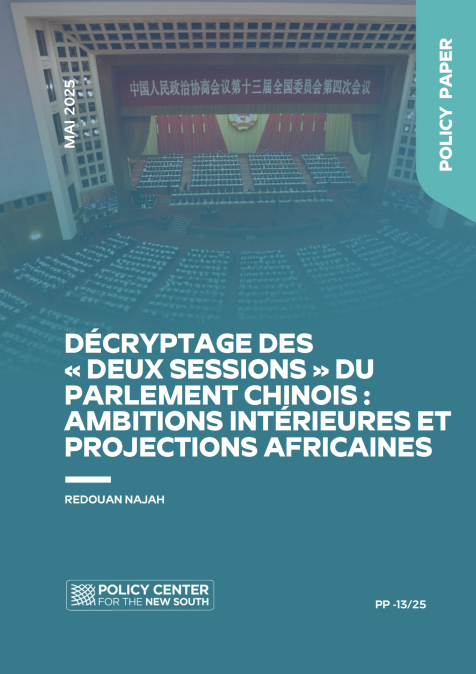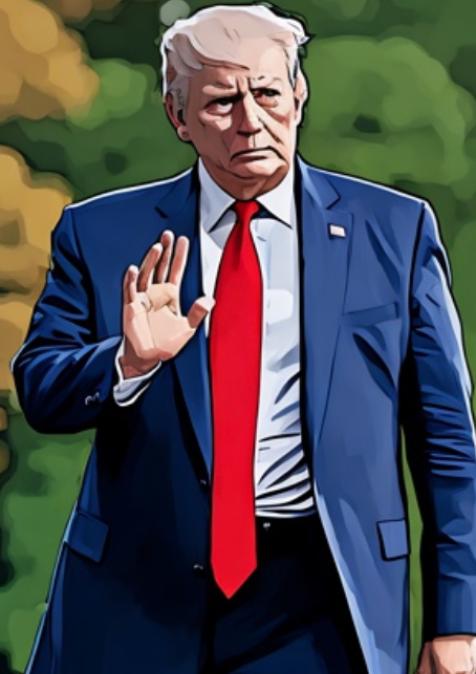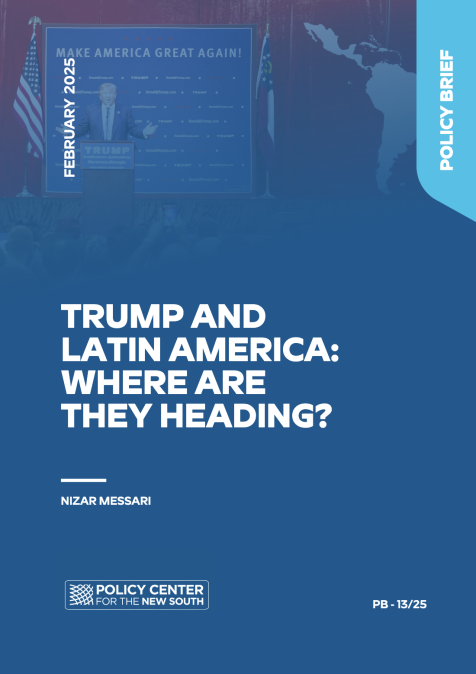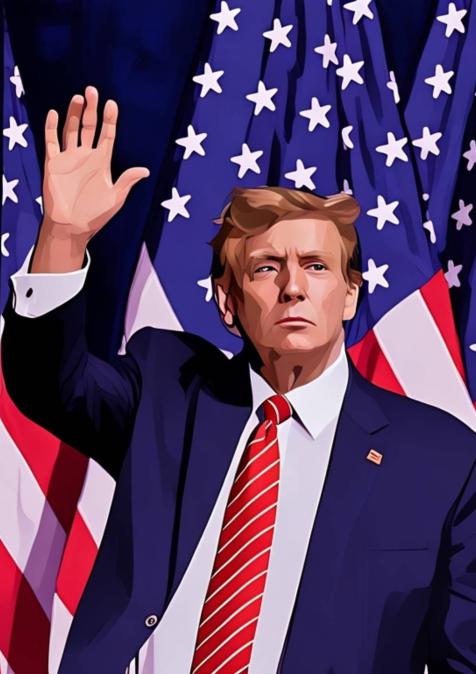Publications /
Policy Brief
Almost a year after President Donald Trump’s return to the White House, the United States displays little of the isolationism many of the country’s international partners anticipated, and many of Trump’s supporters desired. From economic sanctions to military intervention, Trump is proving to be something of a foreign policy president, although with distinctly unilateral instincts. This approach is particularly evident in Washington’s current approach to the ‘South’, including Latin America, the Caribbean and Africa. Much of this marks a sharp departure from the policies of the Biden Administration. Ideological affinity, a distaste for multilateral diplomacy and democracy promotion, and a focus on regional competition with China will continue to be main drivers of the Trump administration’s approach to the South.
BRICS Friction
Recent U.S. administrations have mirrored the tendency of the U.S. foreign policy establishment to minimize the significance of the BRICS as a collective influence. If anything, the expansion of the grouping has reinforced the perception that the BRICS lack the cohesion and capacity for concerted action. Ironically, the Trump administration has paid a great deal more attention to the BRICS as a force aligned against U.S. economic and geopolitical interests. Activism within the BRICS grouping has fueled assertive and highly-critical U.S. policies toward Brazil and South Africa. In both cases, ideology is also at play, but BRICS membership has become emblematic of what President Trump seeks to oppose on the international scene, from alignment with Russia and China, to building alternatives to the dollar in global commerce. The Trump administration’s instincts are hardly multilateral, but a global order defined by ‘America first’ is essentially incompatible with new alignments aimed at challenging U.S. primacy. However skeptical they may be of the Bretton Woods institutions, the President’s advisors cannot ignore the leverage they have given Washington in key policy domains.
Much more than the BRICS grouping, Brazil, South Africa, and India represent major poles in the Global South. For the moment, Washington has troubled relations with all three countries (‘for the moment’ is an important qualifier given the Trump administration’s propensity for rapid policy shifts). With Brazil, President Trump has pressed for an end to the prosecution of former President Jair Bolsonaro and his associates on charges of plotting a coup and political assassinations, in the wake of his 2022 election defeat. The White House claims the charges are politically motivated with, in their view, clear parallels to the events in the U.S. around January 6, 2021. Over the last year, differences over climate policy, the BRICS, and foreign policy more broadly, have driven a contentious relationship between Washington and Brasilia. But ideological differences and President Trump’s affinity with Jair Bolsonaro and his populist politics are the main points of division driving the Trump administration’s imposition of high, punitive tariffs on Brazilian goods[1]. That said, President Trump could easily change course, perhaps swayed by President Lula’s ability to build positive relationships with unlikely interlocutors (his surprisingly warm relationship with former President George W. Bush is a notable example).
The bilateral relationship with South Africa displays a similar mix of policy differences and ideological friction. Even under the Biden administration, Washington was at odds with Pretoria on policy toward Russia, the Ukraine war, and Gaza. South Africa’s leadership in bringing a genocide case against Israel at the International Court of Justice was a particular irritant for the Trump administration. But, as with Brazil, the Trump administration’s policy toward South Africa has been driven, above all, by ideological differences with the ruling African National Congress. Washington has been particularly critical of the government’s Black Economic Empowerment initiative, a policy it perceives as racially discriminatory. The March 2025 expulsion of the South African ambassador in Washington, following his critical remarks about President Trump and members of his administration, marked a notable low point in a relationship that continues to be shaped by domestic political agendas. In October 2025, the Trump administration announced new and sharply reduced quotas for refugee admissions to the U.S., with the bulk of new admissions reserved for White South Africans.
South Africa currently holds the G20 chair, a role with special significance given Pretoria’s emphasis on multilateral diplomacy. Its agenda for the November 22-23, 2025, summit in Johannesburg is likely to feature a range of priorities at odds with Washington’s inclinations, from social equity to sustainable development and finance. President Trump has announced that neither he nor any member of his administration will attend the summit in Johannesburg
If unchallenged, the current U.S. tariffs of 30% on South African goods, alongside the loss of most of the annual $500 million in U.S. development assistance, will damage South Africa’s economy, although the country is better positioned than many in Africa to absorb these disruptions. South Africa and others have a strong stake in the revival of the African Growth and Opportunity Act, which offered tariff-free exports to the U.S. for some 32 African countries. The Trump administration allowed the act to expire in September 2025, and the prospects for its reenactment are uncertain[2].
After decades of concerted efforts by U.S. administrations of both parties, bilateral relations with India had reached at the start of the Trump administration what many would characterize as a high point. Geopolitical alignment, driven by a shared interest in countering China, underpinned by burgeoning economic, technological, and people-to-people ties, had already brought Washington and Delhi closer[3]. India is also a key partner in the Indo-Pacific ‘Quad’ format, alongside Japan, Australia, and the U.S. The advent of the Trump administration has also brought a degree of ideological alignment with the Modi government and its brand of populist politics. In the space of a few months, however, this strong bilateral relationship has been severely shaken. Tariff ‘sanctions’ of roughly 50% have been imposed on India in response to India’s continued imports of Russian oil. These have already led to a sharp drop in Indian exports to the U.S.
But the list of current irritants for both sides is long, including restrictions on the visas that have encouraged large-scale Indian student and professional travel and migration to the U.S. The Indian government was angered by Washington’s ‘balanced’ approach to the clash with Pakistan in the spring of 2025, and subsequent efforts by the Trump administration to deepen security cooperation with its regional rival. The Modi government resents the suggestion that President Trump was integral to defusing the crisis with Pakistan. President Trump, meanwhile, reportedly resents Prime Minister Modi’s failure to support his Nobel peace prize aspirations. The rapid deterioration in the strategic relationship between Washington and Delhi has thus been driven by a range of differences, from high-political issues (including India’s activism within the BRICS), to matters of personal friction between two populist leaders. The main consequences are bilateral, but taken together with the precarious state of U.S. relations with Brazil and South Africa, the potential implications are far wider. That said, the strategic logic behind Indian-U.S. ties will likely remain. Even against the backdrop of disputes over tariffs, visas, and policy toward South Asia, Washington and Delhi have managed to sign a new ten-year agreement to enhance bilateral defense cooperation[4]. The recent differences are sharp but not immutable.
Southern Exposure
The Trump Administration’s interim National Defense Strategy (the actual document is likely to be published in March 2026 emphasizes homeland security in all its aspects, from missile defense and counter-terrorism, to domestic security and border control. The latter two elements have special relevance to U.S. policy towards the South. From sweeping operations to detain and expel undocumented migrants, to military strikes against alleged drug smugglers in the Caribbean, and from threats over the Panama Canal to troubled relations with Mexico, the Western Hemisphere is back at the top of the U.S. policy agenda.
The Monroe Doctrine is once again a feature of foreign policy debates on U.S. engagement with its southern neighborhood, from its benign developmental aspects to its aggressive sphere-of-interest side[5]. In truth, the U.S.’s southern neighbors have always been aware of both the paternalistic and the more assertive and ‘imperialistic’ aspects of Washington’s posture toward the region. For Mexico or Caribbean island states, the U.S. and its political, economic, and social influence are pervasive and inescapable realities. In terms of U.S. foreign policy, relations in the hemisphere have often had an optional or recessed quality, at least as seen from Washington. The perspective is, of course, completely different when viewed through a regional or local lens. In California and across the Southwestern U.S., the border is at the center of ‘inter-mestic’ concerns. Many communities near the border are essentially transnational in their approaches to education, transport, or policing. Miami is often described as the capital of Latin America, and in logistical, financial, and cultural terms, this terminology has some merit. To a considerable extent, U.S. engagement with its hemispheric neighbors is structural.
In the 2024 election, the Trump campaign placed tremendous emphasis on issues closely bound up with challenges perceived as emanating from the South, from economic security to migration, from drugs to law and order. The notion that free trade had resulted in a bad deal for U.S. business and labor topped the political agenda (it was anticipated in more measured ways by Biden’s pursuit of a “foreign policy for the middle class”). A fair amount of this discourse was about Mexico, alongside others. The complex of concerns over migration and border control had clear resonance with the public, and this discourse was dominated by the perception of uncontrolled migration from the south. The activities of U.S. Immigration and Customs Enforcement (ICE) have generated intense debate, especially in urban settings and agricultural communities across America. Aggressive enforcement operations have spurred concerns about the rule of law. They are also having an immense, disproportionate effect on Latin American communities across the country, from Los Angeles to Chicago and beyond.
From the point of view of the U.S.’s southern neighbors these aggressive domestic policies have given rise to anxiety about political and economic spillovers. Some of these spillovers are already evident in the difficult diplomacy around deportations to countries in Central and South America. The Trump administration may be aligned with El Salvador in these efforts, but others, including Mexico, Venezuela, Cuba, and Colombia, have been highly critical (Mexico remains the leading destination for deportees). North-South friction over migration policy is now a toxic mix of ideological and strategic concerns. Southern neighbors are only beginning to reckon with the potentially destabilizing effects of deportations, reduced avenues for economic migration, and sharply reduced development and security assistance from Washington.
Early in his current administration, President Trump threatened action—even military action—to reassert U.S. control over the Panama Canal, ostensibly in response to large-scale Chinese (actually Hong Kong based) investment in ports adjacent to the Canal. Whether these investments really pose a threat to U.S. use of the Canal, even in the event of a U.S.-China conflict, is unclear. The U.S. is unquestionably able to dominate the sea and airspace around the Canal. Should China attempt to coerce the Panamanian authorities into restricting U.S. access to the waterway, this would likely be a very temporary problem. But the threat to Panamanian sovereignty made an impression, and BlackRock and MSC Terminal Investment Limited have now acquired from Hutchison Ports a controlling interest in the Panama facilities.
U.S. military action in the Caribbean and along the Pacific coast of Central America has been an even more divisive issue in the southern neighborhood. At least 65 people have been killed in around 20 strikes targeting alleged drug smugglers. Almost certainly, the vessels targeted were engaged in smuggling activity of some kind. But serious questions have been raised about the legality and proportionality of the action against what the administration has described as “narco-terrorists.” Without question, the continuing operations have cast a shadow over Washington’s relations with Latin America, above all with Colombia, once a close ally in U.S. counter-narcotics strategy. Colombia’s President Gustavo Petro is now under sanctions from the U.S. Treasury Department, accused of collaboration in the drug trade.
The scale of the recent U.S. military deployment to the Caribbean raises larger questions about U.S. strategic aims in the region. The deployment of substantial air, naval, and amphibious warfare assets, including the movement of an aircraft carrier battle group from the Mediterranean to the Caribbean, suggests that Washington wishes to preserve the option of regime change in Venezuela. While few would mourn the passing of the authoritarian and abusive Maduro regime, the prospect of direct U.S. intervention has reawakened concerns about what many in the region would characterize as U.S. imperialism. The long history of U.S.-backed regime change across Latin America has left a potent legacy, not far from the surface in the politics and foreign policy of key states—not least Mexico and Brazil. Yet, an interventionist posture in the southern neighborhood—the Trump administration has even mooted cross-border strikes in Mexico aimed at drug cartels—will face political limits on the U.S. side, and not just from Democrats. Isolationists and traditionalists within the Republican Party are likely to be wary of operations that risk becoming new ‘forever wars’ close to home.
Like many of its predecessors, the Trump administration has not been shy about intervening in different ways to shape the region’s internal politics. Beyond pressure on the Lula government over the Bolsonaro case, the most prominent recent example is Argentina. Strong backing from Washington, including a roughly $20 billion line of support to the Argentine central bank, probably helped President Javier Milei and his party succeed in the October 2025 mid-term elections, which were widely seen as a referendum on his populist-conservative policies. Support of this kind is not unprecedented. The U.S. provided extensive financial support to hard-pressed governments during the Latin American debt crisis of the 1980s. But that support was aimed at forestalling wider financial contagion in global markets. Washington’s strong backing for Milei has been driven explicitly by the desire to support an ideological ally in the hemisphere.
New regional tests will surely emerge. One near-term question concerns the nature and extent of U.S. recovery assistance to Jamaica in the wake of October 2025’s Hurricane Melissa. The U.S. would be well placed to provide significant emergency aid, and to contribute to reconstruction efforts, not least because of the ongoing build-up of the U.S. naval and air presence in the Caribbean. The dismantling of the U.S. Agency for International Development (USAID) and the extended government shut-down, which started on October 1, 2025, and was still ongoing at time of writing, complicate the provision of assistance. But Washington could still play a key role. Will it choose to do so?
Shifts on Africa
The Trump administration’s approach to Africa has been defined by a number of preferences that affect U.S. policy in multiple settings. First, there has been a predictable and marked shift away from the democracy promotion efforts of the Biden administration. The turn away from democracy initiatives has been accompanied by a strong emphasis on the status of religious and racial minorities—in effect, the rights of Christian and White communities in Africa. These are animating issues for U.S. conservatives, and they have been at the center of the Trump administration’s discourse about Africa. Executive orders have facilitated the migration of Afrikaner asylum seekers to the U.S., and this group is set to receive special treatment under new asylum quotas. Most recently, at the beginning of November 2025, Washington has threatened military action in support of Christians targeted by jihadist movements in Nigeria. The Nigerian government denies that they have ignored attacks on the Christian community in the context of the country’s extended struggle with Boko Haram and other terrorist groups. Alongside tense relations with South Africa, the latest threats of sanctions and intervention from Washington have put the Trump administration at odds with the two leading economic and political actors in Africa.
Second, a stated shift from aid to trade reflects a high degree of skepticism in the Trump administration about conventional development assistance, but also encourages the kind of burden-shifting the administration has promoted in other settings. Europe, Japan, Türkiye, and others are expected to fill the gap. Critics would say that China is better placed to take advantage of a reduced U.S. assistance role. The closure of USAID and the transfer of many of its activities to the State Department has already had a significant effect on African recipients, especially in the areas of health and food security. It also creates conditions for closer links between aid programs and American foreign and security policy objectives. On trade, as already noted, the administration may yet choose to renew the African Growth and Opportunity Act. But the current emphasis is clearly on commercial policy, including the Prosper Africa initiative, and support for investments in infrastructure and resource development. The Trump administration has not been shy in describing these as national-security initiatives.
Third, there are also some notable elements of continuity with previous U.S. administrations. Washington continues to frame much of its strategy toward Africa in the context of competition with China, and in the security realm, with Russia. This framing is bound up with growing concern over access to critical raw materials, and the potential for new resource agreements in Africa to offset Chinese dominance in the extraction and processing of rare earths. It also touches on the long-running debate about the implications of Chinese investment in ports and other infrastructure, including in North and West Africa. Counter-terrorism is another point of continuity. Development assistance may be declining, but defense cooperation, and the potential use of force, remain important instruments of policy, notably in West Africa, the Sahel, North Africa, and the Horn.
One Year On: Turbulence, Personalities, and the Shadow of Domestic Politics
For an administration focused explicitly on ‘America First’ and homeland security, the last months have been characterized by a surprising degree of U.S. international activism. China, Russia, the Ukraine war, Iran, Gaza, and transatlantic relations have been key spheres of action. But the Trump administration is also engaged in a set of turbulent, personality-driven relationships with countries across the Global South, and most directly in its own southern neighborhood. In a sense, this is no accident. From the presidential campaign onwards, President Trump and his advisors have underscored the importance of issues at the nexus of domestic and international policy—trade, migration, security, and conservative ideology. Together with the threat of sanctions and military intervention, these elements have shaped U.S. bilateral relations, from South Asia to Latin America, from South Asia to the Caribbean. They are also bound to provoke unease in many places where sovereignty consciousness and multilateral diplomacy remain articles of faith. In this setting, U.S. relations with actors in its own hemisphere and across the South will be less aspirational and more hard-edged, with domestic connections at the top of the agenda.
[1] The Trump administration levied tariffs of 50% on Brazilian goods. On October 28, 2025, the U.S. Senate passed a bill to block the imposition of these tariffs. Notably, the bill gained the support of several Republican senators. The measure is unlikely to have the necessary support in the House to become law. In recent years, the U.S. has actually had a substantial trade surplus with Brazil.
[2] See Rob Rose and David Pilling, ‘South Africa Says the US is Pressing for Policy Change’, Financial Times, October 23, 2025, p.2.
[3] Raja Mohan makes a very clear case for India’s growing strategic importance, even in cooperation with an unpredictable U.S. partner. See C. Raja Mohan, India and the Rebalancing of Asia (London: International Institute for Strategic Studies, 2025).
[4] Manu Pubby, ‘India, US Sign 10 Year Framework Pact for Defence Partnership’, The Economic Times, October 31, 2025.
[5] For an excellent recent discussion of the long history of north-south interaction in the Americas, see Greg Grandin, America, América: A New History of the New World (New York: Penguin Press, 2025).









